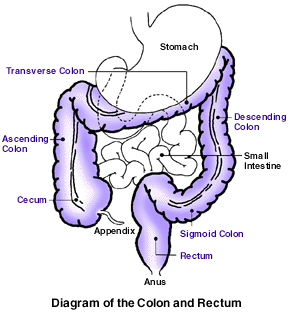

|
 |


Colorectal Cancer >
Screen for Life > Colorectal Cancer Glossary of Terms
Colorectal Cancer Glossary of Terms
Anus
- The opening of the rectum to the outside of the body.
Cancer
- A disease in which cells grow out of control. Cancer cells can
invade nearby tissue and spread to other parts of the body.
Colon
KO-lun (WAV-32K)
 |
The long, coiled, tube-like organ (also known as large bowel or
large intestine) that removes water from digested food. The
remaining material, solid waste called "stool," moves
through the colon and the rectum and leaves the body through the
anus. Parts of the colon include: cecum, ascending colon, transverse
colon, descending colon, and sigmoid colon. The average colon is
approximately 6 feet long. |
Colonoscope
ko-LON-o-skope (WAV-40K)
- A flexible, lighted instrument with a built-in tiny camera used to
view the inside of the entire colon and rectum.
Colonoscopy
ko-lon-OS-ko-pee (WAV-54K)
- An examination in which the doctor looks at the internal walls of
the entire colon through a flexible, lighted instrument called a
colonoscope. The doctor may collect samples of tissue or cells for
closer examination. The doctor may also remove polyps during
colonoscopy.
More information
Colorectal
ko-lo-REK-tul (WAV-42K)
- Related to the colon, rectum, or both.
Double Contrast Barium
Enema
(WAV-66K)
- A series of x-rays of the colon and rectum. The x-rays are taken
after the patient is given an enema, followed by an injection of air. The barium
outlines the intestines on the x-rays, allowing many abnormal growths
to be visible.
More information
Fecal Occult Blood Test
FEE-kul o-KULT (WAV-70K)
- A test to check for hidden blood in stool. Fecal refers to stool.
Occult means hidden. Sometimes called "F.O.B.T." (also see
"Stool Test")
More information
Flexible Sigmoidoscopy
sig-moid-OSS-ko-pee (WAV-52K)
- Also called proctosigmoidoscopy. A procedure in which the
doctor looks inside the rectum and the lower portion of the colon
(sigmoid colon) through a flexible, lighted tube called a
sigmoidoscope. The doctor may collect samples of tissue or cells for
closer examination and remove some polyps within view.
Gastroenterologist
GAS-tro-en-ter-OL-o-jist (WAV-66K)
- A doctor who specializes in diagnosing and treating disorders of the
digestive system (which includes the esophagus, stomach, pancreas,
intestines, and liver).
Gastrointestinal Tract
GAS-tro-in-TES-ti-nul (WAV-62K)
- The part of the digestive tract where the body processes food and
eliminates waste. It includes the esophagus, stomach, liver,
intestines, and rectum.
Intestine
- The long, tube-shaped organ in the abdomen, also called the
"bowel", that completes the process of digestion. There are
both a large and small intestine.
 Polyp Polyp
(WAV-36K)
- An abnormal, often precancerous growth of tissue (colorectal polyps
are growths of tissue inside the intestine).
Rectum
(WAV-22K)
- The last 8 to 10 inches of the large intestine. The rectum stores
solid waste until it leaves the body through the anus.
Screening Test
- "Screening tests" are tests used to check, or screen, for
disease when there are no symptoms. Screening tests for colorectal
cancer include: fecal occult blood
test, flexible sigmoidoscopy, colonoscopy,
and double contrast barium
enema. (When a test is performed to find out why symptoms exist,
it is called a "diagnostic" test).
Sigmoidoscope
sig-MOY-da-skope (WAV-48K)
- A flexible, lighted instrument with a built-in tiny camera that
allows the doctor to view the lining of the rectum and lower portion
of the colon.
More information
Stool
(WAV-30K)
- The waste matter discharged in a bowel movement; feces.
Stool Test
- A test to check for hidden blood in the bowel movement. (also see
Fecal Occult Blood Test)
Sources for definitions: National Cancer Institute and Centers for
Disease Control and Prevention.
|
 |




